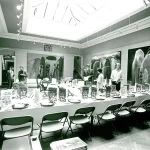
From our early days, since our founding by Aitken Dott in 1842 in South St. David Street, The Scottish Gallery has been very much a part of the history of Scottish Art over the last 181 years, first as gilders and picture restorers and from the turn of the century, as the leading promoter of Scottish Contemporary Art. As the course of Scottish art developed during the enlightenment, artists began to exist independently of their patrons and require galleries and exhibitions in which to display their paintings for sale. It is our close bond with artists and our audience which has sustained us so successfully and for so long.
Aitken Dott & Son est. 1842
We are part of a living culture – heritage in use – forming part of the character of Scotland’s cultural map. Tens of thousands of paintings and objects have been sold by the gallery and bear our trade label. Many dozens of craftsmen were apprenticed here, and many hundreds have earned a living from the company’s varied activities. Most importantly, artists were given an early opportunity to exhibit their work and saw their careers blossom with the nurture of The Scottish Gallery.

Aitken Dott & Son 1860 – 1900s

In 1860, our business expanded so much that we needed new premises and we relocated to 26 South Castle Street. This new space included an artist materials department, a framing department, a print department and rooms to rent for artists.
From 1874-1882, the Scottish Arts Club rented rooms above the gallery in South St David Street as a meeting place for debate and relaxation for artists – it was therefore a natural business development for Aitken Dott to hand up and sell the new work of the artists flocking to his shop. In the 1880’s, Aitken Dott’s niece campaigned to be able to rent a room at the gallery to exhibit her work. After that, woman artists approached the gallery to exhibit and sell their work.
In 1897, The Scottish Gallery was created by Aitken Dott’s son, Peter McOmish Dott, who was by now a partner with the firm alongside his brother Langair. McOmish was a scholar and astute businessman. It was his idea to create The Scottish Gallery to differentiate picture dealing from other parts of the business. The event was publicised in the Art Journal in 1897. The article highlighted the works by W D Mackay, Hugh Cameron, Sam Bough, William McTaggart and James Lawton Wingate. McComish Dott wrote extensively on the work of William McTaggart in his major exhibition of 1907, which celebrated fifty years of association with The Gallery.
The 20th Century
In 1903, the Scottish Colourist S.J. Peploe held his first solo exhibition at The Gallery. After the War and into the Great Depression. The Gallery was run by George Proudfoot from 1915, taking the business forward from the Dott family. The 1920’s were sustained by the work of S.J. Peploe and George Leslie Hunter and The Gallery specialised in etchings in the period of the great etching boom when The Gallery would send lists of new publications all over the world. In 1929, Sir William MacTaggart held his first one man show, the first of his career whilst the avant-garde painter William Johnstone’s first one man show in 1935 sunk without a trace. In 1934, Anne Redpath returned to Hawick in the Scottish Borders after several years of living in France – she would begin the journey to establish her outstanding career – she became a regular exhibitor at The Gallery. In 1936 we held the Memorial exhibition by S.J. Peploe.

WWII and the birth of the Edinburgh International Festival
From 1940, The Scottish Gallery was steered by Miss Beatrice Proudfoot, who was George Proudfoot’s sister in the advent of his death. She created a significant programme of exhibitions, including British and French artists including paintings by William Steer, Duncan Grant, L S Lowry, Robert Colquhoun and Robert MacBryde, Monet, Matisse, Vuillard, Derain, Dufy, Boudin and many others. These were established artist of part of the avant-garde. She also organised several Polish exhibitions including Josef Herman in 1942 who had found his way to Scotland in 1940. Her polish exhibitions also included women artists and The Gallery welcomed these vital ‘degenerates’ who had escaped Europe. Aleksander Zyw exhibited at The Gallery from 1945.
1947 – The Edinburgh International Festival was created in the spirit of the arts to bring unity and solidarity. The Gallery mounted its first ever Festival show with S.J. Peploe. Denis Peploe also held his first solo exhibition at The Gallery after serving 6 years in WWII.
1949 – HRH Queen Elizabeth visited The Scottish Gallery.
Our programme of exhibitions were by now all inclusive – probably the only gallery in the country to include female artists alongside their peers.

1950 – 1960s
1952 – Joan Eardley begins to exhibit at The Gallery
Dott’s played an increasingly important part during the post-war years. If truth is the first casualty of war, culture must be a close second, and after six barren years there was a huge public demand for art – The Arts Council, the Edinburgh Festival and the Festival of Britain, innumerable large exhibitions all indicated the surge of enthusiasm and endeavour. Aitken Dott’s was mainly responsible for the great wave of public interest in Scottish contemporary paintings in the 1950s and 60s and a flowering of talent was noticeable in The Scottish Gallery. Many people became first time picture buyers not in any sense of being collectors but as home owners who wanted to have original works of art to enjoy. Prices were still very modest, unaffected by fashion or vanity and what a galaxy of talents there was to enjoy! Jack Firth Artist and writer, 1992 (150th anniversary)
1980s
In 1982 The Gallery moved from Castle Street to George Street, to allow for large scale exhibitions of the era: John Bellany, Robin Philipson, Bruce McLean, Jock McFadyen etc. Our openings attracted up to 500 guests and were famous for ‘the rammys’. During this period, the Edinburgh School was been firmly established by The Gallery and we opened a permanent Department for Craft. Guy Peploe joined the Gallery in 1983. The 1980’s were dominated by art fairs – international, Europe and countless art fairs up and down the country.

1990s
The Millennium and Beyond
The Gallery continues to thrive in its current location on Dundas Street in the heart of Edinburgh’s New Town which has a world heritage status. The Gallery celebrated its 175th anniversary in 2017 and since the pandemic in 2020 The Gallery is a thriving real gallery with gardens and enjoys a creative digital presence. The Gallery continues to celebrate and support artists from Scotland, artists who come to live in Scotland, the UK and internationally, with a dynamic programme of both contemporary, vintage and historical exhibition programme.
















